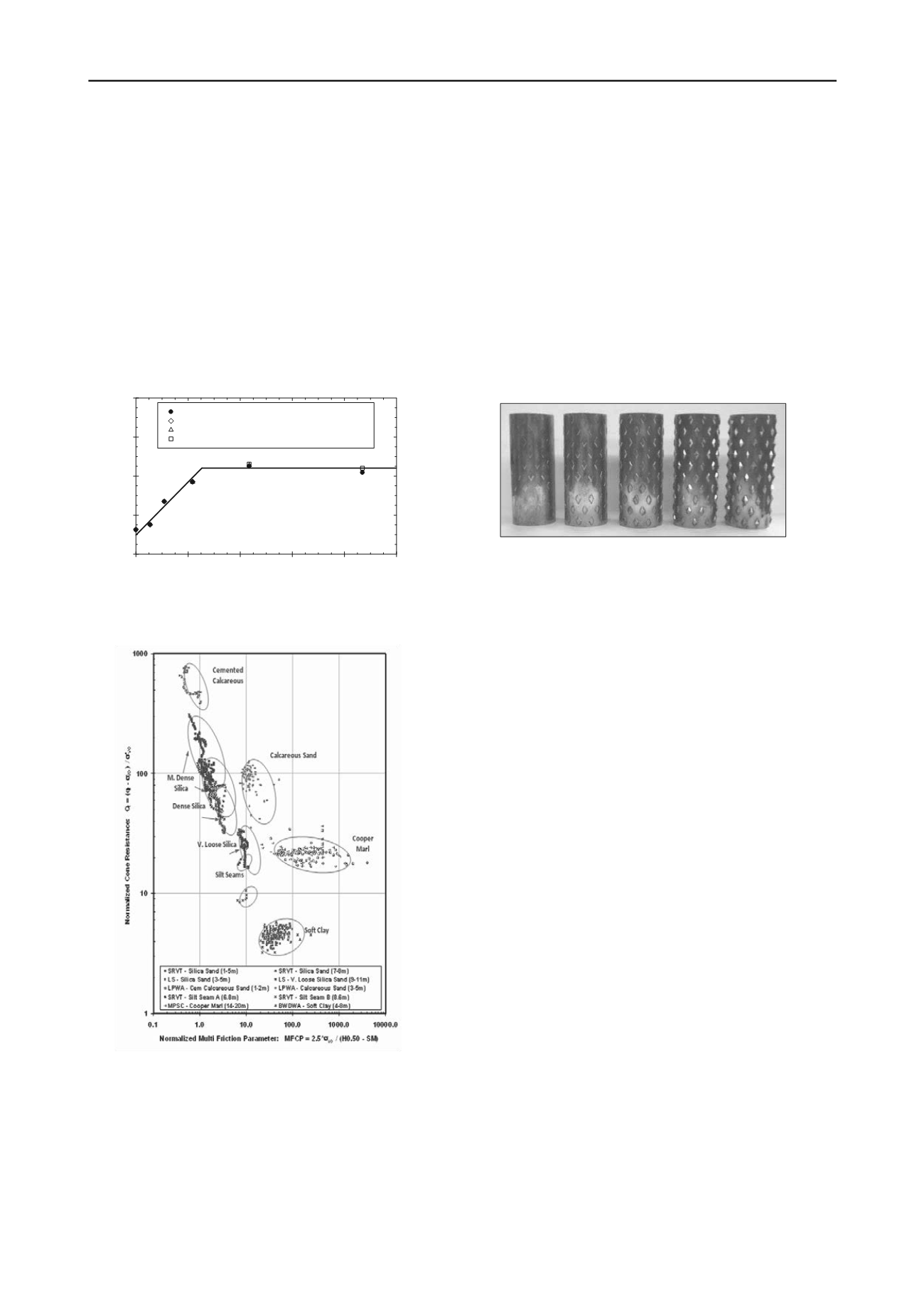
529
Technical Committee 102 /
Comité technique 102
and location, with the goal of measuring both axial and
torsional shear responses of the soil throughout the same
sounding. In this manner, the effects of special variability
(vertical and horizontal) will be eliminated and more
detailed information about the soil’s anisotropy and state of
stress can be provided. The proposed texture of the
MPFTA’s friction sleeves is the same to the texture of the
MFA and MPFA’s sleeves as shown in Figure 5. The
friction sleeve texture pattern consists of machined diamond
shaped features with a height that typically ranges from 0.25
to 2 mm in order to induce different degrees of shearing.
The configuration of penetration angle, diamond width,
diagonal spacing, texture slope and areas with no textural
features ensures that shearing is induced with the soil and
prevents clogging of the textural features.
Normalized Roughness, R n * (=R max (diamond height)/D 50 (sand))
0
2
4
6
8
10
Interface Sleeve Stress (kPa)
0
100
200
300
400
Values from Individual Sleeve Tests (Soundings S17-S22)
S31 - CPT - Smooth - 30H.125S3 - 30H.25S3 - 30H.5S3
S32 - CPT - Smooth - 30H.5S3 - Smooth - 30H1S3
S33 - CPT - Smooth - 30H1S3 - Smooth - 30H2S3
Figure 3. Relationship between surface roughness and interface
friction determined using multi-sleeve technology.
Figure 4. Soil Classification Chart based on multi-sleeve data.
3.1 Comparison to Existing In-Situ Testing Systems.
The
MPFTA device has relatively little in common with the in-
situ shear vane test. The shear vane is typically used to
characterize the response of soft clays. The reason is that
stiffer soils can compromise the structural integrity of the
shear vane, resulting in blade bending. It is considered that
this is not a limiting factor for the MPFTA’s frictional
elements because of their different design and thus stiffer
configuration. It is important to note that the MPFTA’s
intent is to the surface interface strength of the soil in the
axial and radial directions, while the shear vane’s intent is to
measure the soil’s undrained shear strength. Finally, as
shown by Chandler (1988), different diameter sizes can
impose strain-rate effects; however since the diameter of the
MPFTA device is constant and only the height of the
diamond texture elements changes, the results of the
MPFTA will not need to be corrected for this and other
potential geometry effects.
Figure 5. MFA and MFPA’s friction sleeves with increasing
diamond height (from left to right)
3.2 Sleeve Locking Mechanism.
For the MFA and MPFA
devices, the axial force is derived from measurements using
a series of bonded strain gauges configured as the four-
branches of a wheatstone bridge. Application of the soil
shear force on the textured sleeves brings them into contact
with a “shoulder” and the resulting change in length of the
bonded strain gauges changes the output of the Wheatstone
bridge. In order to measure the torque applied when the
sleeve is rotated, the sleeve is temporarily fixed to the core
of the mandrel by an electromagnet which prevents rotation
of the sleeve and instead induces changes in resistance of a
set of orthogonally bonded strain gauges also configured as
the branches of a Wheatstone bridge. Given the magnitude
of the forces on even the most heavily textured sleeves,
relatively low currents are required to “lock” the
electromagnets and thus sleeves during torsional testing. A
sketch and photograph showing the axial and torsional load
application modes for the new device are shown in Figure 6.
Final designs of the actual combined axial-torsional cell are
being completed. Once measurements at a given sounding
elevation are completed, the electromagnets are turned off
and the penetration of the device and recording of axial
loads is continued. In many instances, the device will be
advanced so that a sleeve is advanced to the same elevation
that the adjacent preceding sleeve was located at in a
previous torsional test so that successive torsional test
measurements are made at the same elevations with sleeves
of increasing texture height. This eliminates the need to
account for lateral and vertical variability since successive
tests are performed on the same material.


